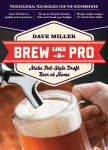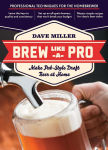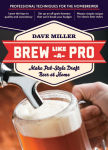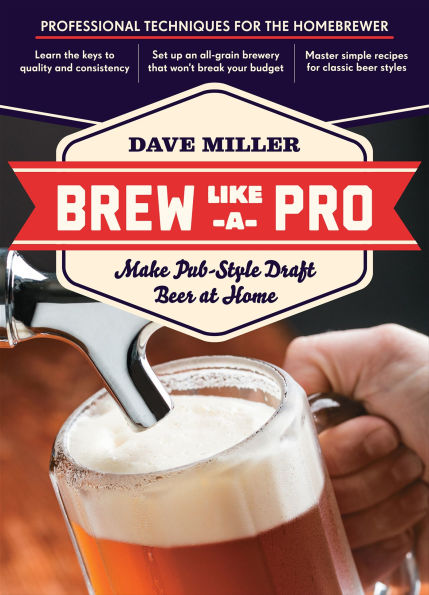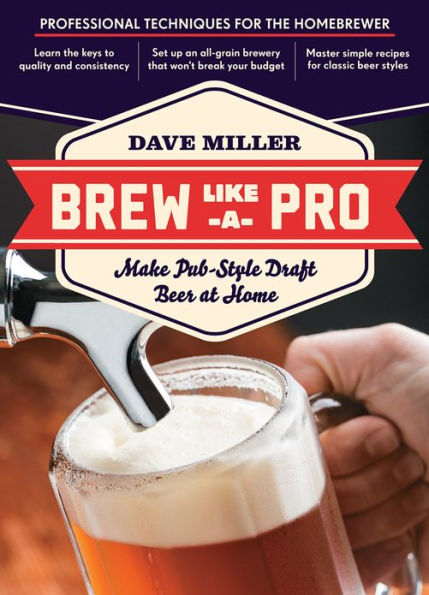Make your best beer ever! Legendary brewer Dave Miller brings a lifetime of professional experience into your home. With complete plans for a system that requires just 18 square feet and full of small-batch recipes, Brew Like a Pro reveals the secrets of truly great draft- and pub-style brewing. Learn to make classic all-grain beers that stay fresh in kegs for months, eliminating the need for bottling. This clear, concise guide is sure to take your homebrewing to the next level.
Make your best beer ever! Legendary brewer Dave Miller brings a lifetime of professional experience into your home. With complete plans for a system that requires just 18 square feet and full of small-batch recipes, Brew Like a Pro reveals the secrets of truly great draft- and pub-style brewing. Learn to make classic all-grain beers that stay fresh in kegs for months, eliminating the need for bottling. This clear, concise guide is sure to take your homebrewing to the next level.


eBook
Available on Compatible NOOK devices, the free NOOK App and in My Digital Library.
Related collections and offers
Overview
Make your best beer ever! Legendary brewer Dave Miller brings a lifetime of professional experience into your home. With complete plans for a system that requires just 18 square feet and full of small-batch recipes, Brew Like a Pro reveals the secrets of truly great draft- and pub-style brewing. Learn to make classic all-grain beers that stay fresh in kegs for months, eliminating the need for bottling. This clear, concise guide is sure to take your homebrewing to the next level.

Product Details
| ISBN-13: | 9781603428521 |
|---|---|
| Publisher: | Storey Publishing, LLC |
| Publication date: | 05/01/2025 |
| Sold by: | OPEN ROAD INTEGRATED - EBKS |
| Format: | eBook |
| Pages: | 370 |
| File size: | 16 MB |
| Note: | This product may take a few minutes to download. |
About the Author
Dave Miller is the author of Brew Like a Pro and Dave Miller's Homebrewing Guide, published by Storey in 1995. He was a brewer at Blackstone in Nashville from 1994 to 2008. During his tenure there, Blackstone's beer won 14 Great American Beer Festival and World Beer Cup medals. In his retirement, he has returned to the world of homebrewing. He was awarded a Lifetime Achievement Award from the American Homebrewers Association.
Read an Excerpt
CHAPTER 1
HOW I GOT HERE
For those of you who do not know me, I guess I need to tell you a little about myself and my involvement in the world of craft beer. I started out as a homebrewer, but after about 15 years I "turned pro" and pretty much got away from the hobby side. I quickly discovered that brewing in a pub is a tough job, even for a young man. It requires lifting and lugging heavy sacks, crouching and kneeling on hard floors, filling (by hoe and shovel) and moving cartloads of wet spent grain, and much other heavy labor. For a middle-aged man, as I was at the start, it was a test of dedication. Every night I came home tired and sore, and the last thing I wanted to think about on my days off was making beer.
It took a year of retirement from professional brewing before my interest began to revive. This book is a field report of my reentry into homebrewing. A lot changed in homebrewing while I was away. I hope I am not being presumptuous in saying that I had something to do with that.
I made my first batch of homebrew in 1976. It was a typical recipe of the time, made with a 21/2-pound can of "malt extract" (actually partly corn syrup), 4 pounds of corn sugar, half a 4- ounce brick of compressed "kettle hops" (lacking a scale, I just cut the brick in half — it was brown all the way through), a 1-ounce bag of "finish hops" (loose in a plastic bag, a little greener than the hop brick), and a packet of "lager yeast" (origin/manufacturer unspecified).
The result was just what you would expect. It smelled more like cider than beer. It was thin as water, with barely a hint of malt character, and had a bitterness level that was way out of balance with its ultralight body. I took a bottle to the owner of the local shop where I had purchased the ingredients, and he poured some into a glass, swirled it around, sniffed and tasted, and with a laugh announced, "That's good beer."
That should have been the end of the story. For the life of me I cannot explain why I persisted, but I did. I read every book I could find on the subject of homebrewing, profiting little from most of them, but eventually discovering The Big Book of Brewing, written by an Englishman named Dave Line. This chap had the temerity to suggest that homebrewers can, and should, take the trouble to make their beer from malted barley and other grains, just as commercial brewers do. That set me off.
In 1981 I won Homebrewer of the Year at the AHA (American Homebrewers Association) national competition, with a Dutch pilsner that today, I'm sure, would not make it out of the first round. But that was then, and the award confirmed what I already knew: that Dave Line was right. All-grain brewing, as it is still called in the homebrew world, is the way to make beer.
Then and Now
Homebrewing has come a long way since then. As the craft beer movement has taken off, the marketplace has responded to the corresponding growth of the hobby, and today homebrewers have access to just about everything available in the line of ingredients, including fresh hops of all varieties, every type of malted barley, and dozens of strains of yeast from breweries all over the world. In that respect, the playing field has been leveled. The best beers that I have tasted in homebrew competitions are beers that practically any professional brewer, including me, would be proud to sell.
Likewise, the information explosion has benefited the hobby just as it has so many other pursuits. Books, magazines, and websites abound. Once I got the itch to homebrew again, I read a lot of the new material. I got excited by the prospects of quick, simple, all-grain brewing using products and techniques that promised commercial-quality results with little effort and a minimum of equipment. In fact, my initial plan was to use only low-cost off-the-shelf gear, permitting myself just one exception: a lauter tun that I decided to build because the design I preferred is not available ready-made.
Some of you may be surprised to hear this. You might think the natural course would be to get a nice single-tier brewing "rack," as I call them, and go to town with it. Maybe you have seen these systems — a welded frame, three big kettles, three burners and a gas rail, three pumps, and yards of beautiful stainless piping. No doubt I could have been turning out good beer within days of taking delivery.
But I've done that. I worked with brewpub systems for nearly 17 years, first at The Saint Louis Brewery (makers of Schlafly) and then at Blackstone Restaurant & Brewery in Nashville. While they were not as flexible in some ways as the best homebrewers' racks, the gear was pretty much on the same level. I wanted to do something different. I have always had a minimalist streak, which I suppose is a euphemism for being cheap. I blanch at the prices of these "ready-to-brew" systems. I wanted to demonstrate, first of all to myself, that you don't need all that to make first-class beer.
The Limits of Simplicity
Then I started brewing. My first batch, brewed using the simple methods and equipment I wanted so much to champion, was from every point of view a disaster. Using the finest ingredients, including yeast from my former place of employment, I made a beer that was not worth drinking.
To be clear — it was not undrinkable, nor was it infected. But it was not worth drinking. A comparison with the pub beer that shared space in my beer fridge proved that beyond a doubt.
Things got a little better after that, as I corrected some deficiencies in the methods I was using. By the time I had made and flushed a few batches, I realized that simplicity can be taken too far. You compromise the quality of your wort. And bad wort makes bad beer.
As I continued to brew, I found that in order to improve the beer, I had to either modify a piece of equipment, or rethink how I was using it, or replace it with a new one. And in every case, these changes in equipment and procedure led in one direction, which was (as I should have expected) doing things the way I had done them when I was a professional.
Suffice it to say I recognized anew the merit of the typical pub brewery, which instances a series of design decisions that have been gradually worked out to make high-quality results possible with a minimum investment in floor space and capital.
This is not to say that every pub brewer makes the best use of his machinery. And not all pub breweries are, by any means, up to standard as far as equipment goes. I have seen systems so ramshackle that it seemed impossible to make good beer with them. Sometimes I have been surprised at how good the beer actually was — a tribute to the skill of the operator.
This also is not to say that I ended up with a miniature replica of the Blackstone brewery. What I attempted to do was to achieve the same functionality, in terms of process, ease of operation, and safety. The next two chapters explain what I was shooting for, and my design criteria and decisions.
Looking back, I don't know why I was surprised at the results I got from my first batches. After all, I'm the guy who turned his back on extract brewing and implored countless others to do the same, precisely because the simplicity of the process is bought at the price of low-quality wort.
The Place (or Lack Thereof) of Malt Extract
I am not saying that I have never tasted a good beer that was made from malt extract. I have. I have even tasted a few that deserved, and got, medals from judging panels that I sat on. But for every beer of this caliber, I have tasted dozens that were mediocre despite being free of infection and other typical flaws. Their downfall was the unmistakable "extract note" that is quite different from the malt flavor of beer that is made in the traditional way.
Where does this "extract note" come from? And why do some, though few, extract beers seem to escape it? These are questions that have puzzled me for years. So far, the best answer I have found is that the process of vacuum evaporation is the culprit. I won't go too far into the technical side of it, but the creation of malt extract syrup requires an extreme degree of concentration; the product is about 80 percent solids, compared with 12 percent for an average wort. The end result is a syrupy substance that has been darkened and caramelized and is, apparently, highly unstable. It begins to deteriorate as soon as it is made. To paraphrase what Dr. Johnson said about Scotsmen, then, something may be made of a malt extract — if it be caught young.
The trouble is that catching it young — and I mean within a few weeks of its manufacture — is highly problematic. Nobody is putting "born on" dates on packages of malt extract. And the alternative to syrup — spray-dried granular malt extract — seems scarcely any better. True, almost all the moisture has been removed, and that should make it more stable. But the drying process itself is a further insult. How all this will balance out in any particular case, such as a trial making the same recipe from one particular package of dry extract and one particular package of syrup, is unpredictable. It depends on the age of the samples in question and on manufacturing conditions, which may not be the same from one maker to another or even from one batch to another.
The only thing you can be sure of is this: the more a particular beer style depends on a clean malt flavor, the less suitable it is to being made from extract. Your best chance for a good result is probably something like a porter, with its caramel and roasted grain notes, or a well-hopped amber ale. Even here, of course, if the extract is old or otherwise defective, your beer will suffer. But you have a chance. On the other hand, if you are trying to make a pilsner or a wheat beer, forget it. The freshest extract in the world will not give a creditable result.
Those are the facts, and here's my conclusion: extract brewing is a blind alley. It is a good introduction to the brewing process, and I still recommend that everyone make a few batches of extract beer to get familiar with boiling, hopping, cooling, fermenting, and packaging. As an educational exercise it is useful. But look on it in that light. Don't think you will be able to make consistently good beer with this method, and don't get sidetracked into a series of brews where you try different brands of ingredients in the hope of improving your results.
In this book I am not going to go into extract brewing. I did that in some of my older books, and there are others with plenty of information and recipes. Some are listed in Resources (see page 255). I have not made a batch of extract beer in 20 years, and I did not go back into homebrewing with that in mind. What I wanted was to make beer as good as I made at work, and for that I'd need a plan.
Blueprint to Brew
As I said, my goal was simple: make beer similar to the beer I made at the pub.
That immediately dictated some choices, the most obvious of which is all-grain brewing. Almost as clear was another, which I have never questioned or regretted. I state it here as a bit of advice to you.
Dear Reader:
Don't waste an hour or a dollar on bottling.
Pub beer is draft beer, and draft beer is best because it is the freshest and subjected to the fewest insults after it is made.
Draft beer is unpasteurized, and it is kept cold from the end of fermentation until it reaches its destination in the stomach of a happy beer lover.
Draft beer is served from kegs.
Therefore, the first thing you should get is not a kettle or a fermenter, but a draft beer system, including a few kegs and a refrigerator.
As it happens, I already had a draft beer system before I went back into homebrewing, because my "pension" from Blackstone is, basically, unlimited free beer. All I need to do is take an empty keg in for a refill and pick it up the next day. That puts some light on the length of time it took me to go back into brewing. If I had been lacking good fresh beer, it would have happened a lot sooner.
So, here I am telling you to spend a few hundred bucks on a draft system, right up front. For most homebrewers it is one of the last things they pony up for. I say, do it now. Money spent on a draft system repays you from the start. De-labeling, cleaning, and sanitizing 50 bottles (enough for a 5-gallon batch) is a wet, nasty job that takes hours. Filling bottles is almost as tedious. I was a bottling homebrewer for 17 years, and I clearly remember the day I brought home my first keg as a day of liberation. Believe me: Money and time spent on bottles is a waste. At best you will be able to pass them along to a new brewer, and all that does is perpetuate the cycle of misery.
Allow me to present my case for investing in a draft system:
* First: A refrigerator has other uses besides beer service. It helps you make better, cleaner-tasting beer. It facilitates post-fermentation crash cooling and clarification.
* Second: It allows you to brew year-round without buying large quantities of ice. Year-round brewing is part of the game. If you want fresh beer, you have to make it fresh.
* Third: A draft system has value even if you don't persist in the hobby, or if time constraints keep you from producing all the beer you want. Many brewpubs and some micros will gladly fill customers' kegs and, in fact, at Blackstone we have a fair number of regular customers who set up a draft system with no intention of making their own beer. And if worse comes to worst and you revert to buying bottled beer, you can sell the kit and caboodle and get most of your money back.
* Fourth: Brewing is always exciting, an essay in a wonderful art; bottling is drudgery. It is also low-paying work. A draft system is much more cost effective, easily paying for itself with the time you'll save by not bottling your beer. Even if you figure your time is worth only three dollars an hour, a draft beer system will pay for itself in 20 batches of beer. Bottling is worthwhile only if there is nothing you would rather do with your leisure time. I have yet to meet a homebrewer who got into the hobby because he wanted to clean and fill bottles.
That's it. Taking it together, I believe the case for "going draft" is as compelling as the one for going all-grain.
I know that the course advocated here is not the one most of us took into homebrewing. This includes me. But it is the best.
As to what "going all-grain" involves, that is pretty much the subject of the next few chapters. For the benefit of those who are not familiar with the process of making beer, I will start with a brief overview; then we will look at how pub breweries are set up and operated, with the idea of doing the same thing at home, on a smaller scale.
My emphasis here is on practical procedures rather than brewing science. My goal was to limit theoretical discussion as much as possible. There are a number of good books, listed in Resources, that delve into the "whys" in a systematic way; I think anybody who gets serious about brewing will want to read them. But too much information, right at the start, can be an obstacle. It makes brewing seem like something only a chemist could master, and that is far from the truth.
On the other hand, there are some endeavors in which a certain amount of technical discussion cannot be avoided, and in which a willingness to deal with basic math is indispensable. Brewing is one of them. Before you buy one piece of equipment, read through the next few chapters and try to decide whether making your own beer would really be enjoyable for you. If, on the other hand, you have already gotten into this great hobby, then I hope you will use them as a guide to refining your craft.
The emphasis on practical procedures means that, when we come to specifics later on in the book, I am writing about the way I make beer at home. My preferences and habits are on display and, of course, they will not suit everyone. I try to mention some alternatives along the way, but if I am going to keep it simple and straightforward, I really have no choice but to focus on what I know firsthand. However, there are some limitations that come with this. The most obvious has already been mentioned: I am not going to go into extract brewing at all.
What sets this book apart from others you will find is simply that it reflects a different view of homebrewing. When I first turned pro, I tended to look at the process from a homebrewer's perspective. In my return to homebrewing, I find myself looking at it from a pub brewer's perspective. I think my experience has given me a better idea of what is truly necessary and what is just "nice to have" in a home brewery.
In the interests of full disclosure, there is another area where my perspective comes into play. Take a look at the chapter on recipes (chapter 8). I am what you might call a "beer classicist." You may like all the latest permutations and inventions, many of which march under the banner of "extreme beer" — imperial pilsners, double weizenbocks, honey goat cheese cranberry ale, and so on. I do not. Give me a well-balanced Märzen, a rich roasty oatmeal stout, or a tangy witbier, and I ask for nothing else. If you have read the well-known New Yorker article on craft brewing from a few years back (see Resources), I can say it simply: I'm with Garrett Oliver. If you like humongous beers, or monstrously hoppy beers, or monstrously hoppy humongous beers, well, you'll need to look elsewhere for information about them.
(Continues…)
Excerpted from "Brew Like A Pro"
by .
Copyright © 2012 Dave Miller.
Excerpted by permission of Storey Publishing.
All rights reserved. No part of this excerpt may be reproduced or reprinted without permission in writing from the publisher.
Excerpts are provided by Dial-A-Book Inc. solely for the personal use of visitors to this web site.
Table of Contents
1 How I Got Here
Then and Now
The Limits of Simplicity
The Place (or Lack Thereof) of Malt Extract
Blueprint to Brew
Beer 101
2 An Inside Look at a Pub Brewery
3 Building a Home Brewery
Space
Utilities
Equipment for the Draft Beer System
Water Filter
Malt Mill
Mash Mixer
Mash/Lauter Tun and Hot Liquor Back
Sparge Arm
Recirculation Arm
Grant
Brew Kettle/Whirlpool
Burner
Heat Exchangers
Cold Liquor Back
Pump
Aeration Stone and Air Pump
Fermenting Vessels
Racking Arm, Transfer Hoses, and Fittings
Filters
Instruments
Recommended Setups
4 Brewing Materials
Water
Malt and Other Grains
Hops
Yeast
Clarifying Agents
Cleaners and Sanitizers
5 Homebrewing Operations
Before You Start
Before You Brew
Brew Day
Fermentation Management
Filtration and Carbonation
6 Advanced Techniques
Yeast Propagation and Culturing
Lager Brewing
Step and Decoction Mashing
Bottling
Cask-Conditioned Beer ("Real Ale")
7 Projects
Lauter Tun and Hot Liquor Back
Sparge Arm/Recirc Arm
Grant
Two-Stage Heat Exchanger
Thermowell
Pump Speed Control
8 A Handful of Recipes
Appendix: Infusion Rinsing ("Batch Sparging")
Resources
Index
